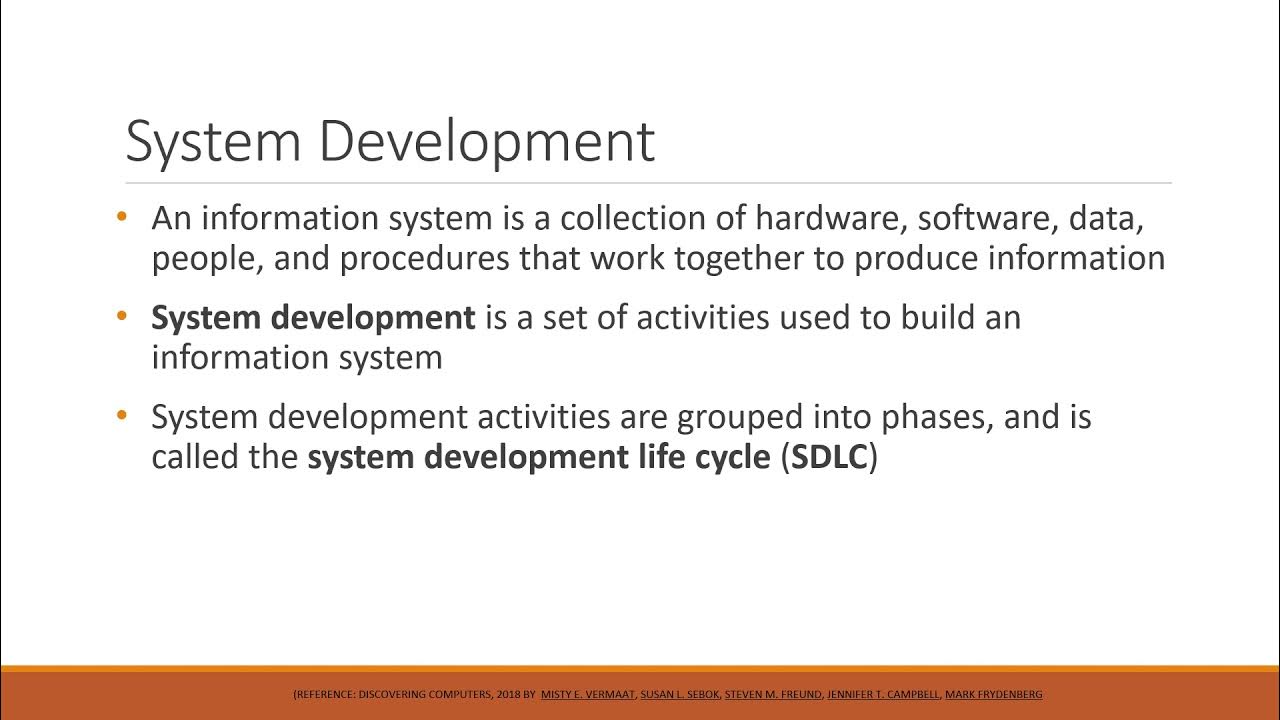Systems Analysis & Design - Ch 1 - Feasibility Analysis
Summary
TLDRThis video discusses the importance of feasibility analysis at the start of a systems development project. It covers three key components: technical feasibility (can we build the system?), economic feasibility (will the benefits outweigh the costs?), and organizational feasibility (does the project align with business goals?). The analysis helps identify risks and guides decision-making, ensuring that projects are feasible and align with organizational strategies. Additionally, it emphasizes the need for continuous reassessment throughout the project to manage evolving risks and ensure success.
Takeaways
- 😀 Feasibility analysis is a crucial first step in evaluating new system projects, addressing whether a project is worth pursuing, feasible, and aligned with organizational goals.
- 😀 There are three main components of feasibility analysis: technical, economic, and organizational feasibility.
- 😀 Technical feasibility assesses whether the system can be built with available technology and resources, and whether risks such as unfamiliarity with the business area or technology exist.
- 😀 To mitigate technical risks, ensure collaboration between technical staff and business users and ensure familiarity with the required technologies.
- 😀 Economic feasibility evaluates whether the benefits of the project outweigh the costs by calculating metrics like ROI, breakeven point, and net present value.
- 😀 Cost-benefit analysis involves calculating both tangible benefits (e.g., increased sales) and intangible benefits (e.g., improved morale) while considering development and operational costs.
- 😀 Organizational feasibility examines whether the project aligns with business strategy and goals and considers stakeholder support, including from management and users.
- 😀 Successful organizational feasibility requires strong project champions and leadership support to ensure alignment with company objectives.
- 😀 Feasibility assessments should be revisited and updated throughout the project to identify and manage new risks as the project evolves.
- 😀 Effective risk management involves recognizing potential risks early, monitoring them throughout the project, and developing strategies to mitigate them (e.g., training or hiring consultants).
- 😀 It is essential to plan carefully and account for risks to avoid project failure, as an estimated 70% of large projects fail due to poor planning, missed deadlines, and scope creep.
Q & A
What are the key components of a feasibility analysis?
-The key components of a feasibility analysis are technical feasibility, economic (financial) feasibility, and organizational feasibility.
What does technical feasibility assess in a project?
-Technical feasibility assesses whether the system can actually be built. It looks at risks related to technology, the experience of the technical staff, project size, and the compatibility of the system with existing systems.
What are the risks associated with technical feasibility?
-Risks in technical feasibility include unfamiliarity with the business application area, lack of familiarity with the technology, large project size, and challenges with system integration.
What factors should be considered when assessing the technical feasibility of a project?
-Factors to consider include whether the technology has been used before, the size of the project, the integration requirements with existing systems, and the expertise of the technical team.
What is economic feasibility and why is it important?
-Economic feasibility assesses whether the benefits of the project outweigh its costs. It is important because it ensures the financial viability of the project by considering factors such as return on investment (ROI), breakeven point, and net present value (NPV).
What are the two types of costs involved in economic feasibility?
-The two types of costs in economic feasibility are development costs (incurred during system creation) and operational costs (ongoing after the system is in place).
How are tangible and intangible benefits different in an economic feasibility analysis?
-Tangible benefits are those that have a direct dollar value, such as increased sales or reduced costs. Intangible benefits do not have a direct dollar value but are still important and should be noted in the analysis.
What does organizational feasibility examine in a project?
-Organizational feasibility examines whether the project aligns with the organization's strategic goals and assesses the level of support from key stakeholders, including management and users.
Why is strategic alignment important in organizational feasibility?
-Strategic alignment is important because a project should support the overall business strategy. Implementing new technologies without considering business goals can lead to misalignment and failure to achieve desired outcomes.
What are some common strategies to mitigate technical risks during a project?
-To mitigate technical risks, teams can provide training for staff, hire consultants with relevant expertise, and adjust project timelines to allow for a learning curve and proper integration with existing systems.
Why is it essential to continuously review and revise the feasibility analysis during a project?
-Continuous review is essential to ensure that identified risks are being managed effectively and to detect any new risks that may emerge as the project progresses, allowing for timely adjustments.
What is the role of a cost-benefit analysis in economic feasibility?
-A cost-benefit analysis helps compare the projected costs and benefits of a project. It is used to determine whether the benefits justify the costs, usually focusing on the first 3-5 years of the project.
Outlines

Этот раздел доступен только подписчикам платных тарифов. Пожалуйста, перейдите на платный тариф для доступа.
Перейти на платный тарифMindmap

Этот раздел доступен только подписчикам платных тарифов. Пожалуйста, перейдите на платный тариф для доступа.
Перейти на платный тарифKeywords

Этот раздел доступен только подписчикам платных тарифов. Пожалуйста, перейдите на платный тариф для доступа.
Перейти на платный тарифHighlights

Этот раздел доступен только подписчикам платных тарифов. Пожалуйста, перейдите на платный тариф для доступа.
Перейти на платный тарифTranscripts

Этот раздел доступен только подписчикам платных тарифов. Пожалуйста, перейдите на платный тариф для доступа.
Перейти на платный тарифПосмотреть больше похожих видео

RPL-4 Perencanaan Perangkat Lunak

Analisis Kelayakan Sistem : Aspek Operasional dan Aspek Hukum

System Development Life Cycle (SDLC)

EKMA4311 Studi kelayakan Bisnis - Pengertian dan ruang lingkup SKB

What is Project Initiation Phase & How to Start a Project? Key Components & Examples - AIMS UK

7 DC18 M11 DBASE
5.0 / 5 (0 votes)
